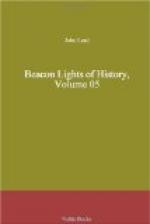Albans, in England, is said to have been six hundred
feet long; and that of Glastonbury, the oldest in
England, five hundred and thirty. Peterborough’s
was over five hundred. The kings of England, both
Saxon and Norman, were especial patrons of these religious
houses. King Edgar founded forty-seven monasteries
and richly endowed them; Henry I. founded one hundred
and fifty; and Henry II. as many more. At one
time there were seven hundred Benedictine abbeys in
England, some of which were enormously rich,—like
those of Westminster, St. Albans, Glastonbury, and
Bury St. Edmunds,—and their abbots were
men of the highest social and political distinction.
They sat in Parliament as peers of the realm; they
coined money, like feudal barons; they lived in great
state and dignity. The abbot of Monte Cassino
was duke and prince, and chancellor of the kingdom
of the Two Sicilies. Tins celebrated convent
had the patronage of four bishoprics, sixteen hundred
and sixty-two churches, and possessed or controlled
two hundred and fifty castles, four hundred and forty
towns, and three hundred and thirty-six manors.
Its revenues exceeded five hundred thousand ducats,
so that the lord-abbot was the peer of the greatest
secular princes. He was more powerful and wealthy,
probably, than any archbishop in Europe. One of
the abbots of St. Gall entered Strasburg with one thousand
horsemen in his train. Whiting, of Glastonbury,
entertained five hundred people of fashion at one
time, and had three hundred domestic servants.
“My vow of poverty,” said another of these
lordly abbots,—who generally rode on mules
with gilded bridles and with hawks on their wrists,—“has
given me ten thousand crowns a year; and my vow of
obedience has raised me to the rank of a sovereign
prince.”
Among the privileges of these abbots was exemption
from taxes and tolls; they were judges in the courts;
they had the execution of all rents, and the supreme
control of the income of the abbey lands. The
revenues of Westminster and Glastonbury were equal
to half a million of dollars a year in our money,
considering the relative value of gold and silver.
Glastonbury owned about one thousand oxen, two hundred
and fifty cows, and six thousand sheep. Fontaine
abbey possessed forty thousand acres of land.
The abbot of Augia, in Germany, had a revenue of sixty
thousand crowns,—several millions, as money
is now measured. At one time the monks, with
the other clergy, owned half of the lands of Europe.
If a king was to be ransomed, it was they who furnished
the money; if costly gifts were to be given to the
Pope, it was they who made them. The value of
the vessels of gold and silver, the robes and copes
of silk and velvet, the chalices, the altar-pieces,
and the shrines enriched with jewels, was inestimable.
The feasts which the abbots gave were almost regal.
At the installation of the abbot of St. Augustine,
at Canterbury, there were consumed fifty-eight tuns
of beer, eleven tuns of wine, thirty-one oxen, three
hundred pigs, two hundred sheep, one thousand geese,
one thousand capons, six hundred rabbits, nine thousand
eggs, while the guests numbered six thousand people.
Of the various orders of the Benedictines there have
been thirty-seven thousand monasteries and one hundred
and fifty thousand abbots. From the monks, twenty-one
thousand have been chosen as bishops and archbishops,
and twenty-eight have been elevated to the papal throne.




